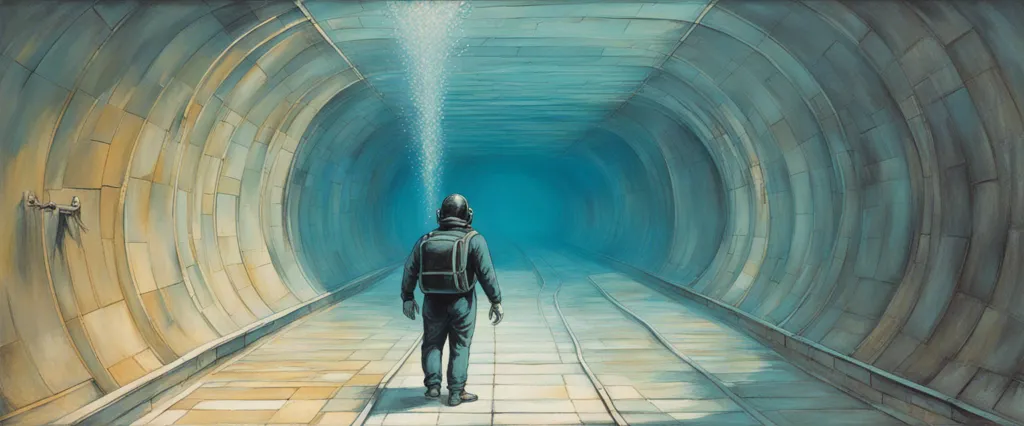
In “The Path of Least Resistance,” Robert Fritz explores the dynamic principles underlying creativity, achievement, and personal growth. As a highly respected composer, filmmaker, and organizational consultant, Fritz seamlessly weaves together his expertise in the arts and his understanding of human behavior to guide readers towards discovering their own path to success. By introducing the power of structural dynamics, Fritz reveals how individuals can reshape their circumstances and manifest the results they desire, all while avoiding the common pitfalls that hinder progress. With thought-provoking insights and practical strategies, Fritz presents a refreshing perspective on overcoming constraints, embracing change, and unleashing one’s creative potential.
Chapter 1: Understanding Structural Tension
Chapter 1 of “The Path of Least Resistance” by Robert Fritz introduces the concept of structural tension and its significance in understanding and addressing problems. The chapter begins by explaining that structural tension is the innate force within all systems that creates a gap between the current reality and the desired outcome. Fritz compares this tension to a rubber band, as it stretches and pulls the system toward its goal.
The author emphasizes that structural tension is different from psychological tension, which stems from stress and anxiety. Structural tension, in contrast, is a positive force that fuels growth, improvement, and innovation. Fritz believes that understanding and effectively managing structural tension is crucial for personal and organizational success.
According to Fritz, most attempts to solve problems focus on finding quick fixes or temporary solutions, without addressing the underlying structural tension. He argues that this approach is flawed because it only alleviates symptoms, rather than resolving the root cause of the problem. Instead, he suggests that true change can only occur when structural tension is recognized and harnessed.
Fritz also highlights the importance of having a clear and compelling vision of the desired outcome. He explains that a strong vision helps to create a constructive tension that propels the system towards its goals. Additionally, the author emphasizes the need for alignment between the vision and the actions taken, as inconsistency can lead to further tension and hinder progress.
In conclusion, Chapter 1 of “The Path of Least Resistance” lays the foundation for understanding the concept of structural tension and its role in problem-solving and achieving desired outcomes. Fritz encourages readers to recognize the positive potential of structural tension and to direct it purposefully towards creating lasting change.
Chapter 2: Shifting from Reactive to Creative Orientation
Chapter 2 of “The Path of Least Resistance” by Robert Fritz, titled “Shifting from Reactive to Creative Orientation,” explores the concept of shifting one’s mindset from a reactive to a creative orientation.
Fritz begins by highlighting how most individuals tend to react to external circumstances rather than proactively pursuing their own desired outcomes. He argues that this reactive approach limits personal growth and fulfillment, leading to a sense of frustration and dissatisfaction. To counter this, he introduces the concept of a creative orientation, which involves taking charge of one’s life and actively working towards desired outcomes.
The author emphasizes that a change in orientation requires a shift in thinking and perception. He explains that the creative orientation involves envisioning what one truly desires, acknowledging the existing reality, and utilizing the current circumstances as stepping stones to reach the desired outcome. Fritz stresses the importance of having a clear vision of the desired end result and aligning all actions and decisions towards that vision.
Moreover, Fritz introduces the idea of structural tension, which is the gap between the current reality and the envisioned outcome. He argues that this tension creates a drive for change and motivates individuals to take action and make decisions that move them closer to their vision. By embracing this tension, individuals can harness their creative abilities and channel them towards achieving their goals.
Overall, Chapter 2 of “The Path of Least Resistance” encourages readers to shift from a reactive mindset to a creative orientation. By taking charge of their lives, envisioning their desired outcomes, and utilizing the tension between the current reality and the envisioned future, individuals can break free from the constraints of reactive thinking and create a path towards personal fulfillment and success.
Chapter 3: Clarifying Your Vision and Goals
Chapter 3 of “The Path of Least Resistance” by Robert Fritz focuses on the importance of clarifying one’s vision and goals in order to achieve success and fulfillment. Fritz argues that having a clear and compelling vision is essential for creating positive outcomes in any aspect of life.
The chapter begins by discussing the concept of an “integrated vision,” which involves a holistic approach to envisioning one’s desired future. Fritz emphasizes that an integrated vision should not only focus on external goals or achievements but also take into account the internal experiences and feelings that one hopes to have.
Fritz introduces the idea of “structural tension,” which he defines as the gap between a current reality and a desired future. He suggests that by embracing this tension and using it as a driving force, individuals can tap into a higher level of motivation and creativity. By clarifying the specific outcomes they want to achieve and understanding the steps required to reach them, individuals can effectively channel their energy and efforts.
The author also highlights the importance of setting goals that are challenging yet attainable, as they inspire individuals to continually push themselves and grow. Fritz suggests that individuals should regularly review their goals, ensuring they are aligned with their vision and adjusting them accordingly.
Additionally, Fritz emphasizes the need for flexibility in goal setting, encouraging individuals to be adaptable and open to change as they progress towards their vision. He cautions against getting fixated on specific plans or rigidly holding onto goals that no longer serve the greater vision.
Overall, Chapter 3 of “The Path of Least Resistance” emphasizes the significance of having a clear and integrated vision, setting challenging yet attainable goals, and remaining flexible in the pursuit of one’s vision. By following these principles, individuals can shape their lives in alignment with their deepest desires and aspirations.
Chapter 4: Overcoming Constraints and Limitations

Chapter 4 of “The Path of Least Resistance” by Robert Fritz focuses on overcoming constraints and limitations. The author delves into understanding the role that constraints play in our lives and how to effectively overcome them.
Fritz explains that constraints are factors that limit or restrict our actions or choices. These constraints can range from physical, environmental, societal, or even self-imposed limitations. He highlights the importance of recognizing that constraints are not obstacles, but parts of the complex dynamic systems in which we operate.
To overcome constraints, the author proposes a shift in mindset. Instead of focusing on struggling against or avoiding constraints, Fritz suggests embracing them as opportunities for growth and creativity. He believes that by examining and understanding the underlying structures causing the limitations, one can effectively transform them into assets for progress.
The chapter emphasizes the principle of “structural tension,” which involves bridging the gap between one’s current reality and the desired outcome. Fritz argues that by creating a clear vision of the desired state and understanding the current constraints, one can establish a system of actions and habits that align with moving towards that vision.
Moreover, the author introduces the concept of “structural conflict,” which occurs when an individual’s actions or habits are in conflict with their desired outcome. Fritz encourages resolving that conflict by reframing the situation and identifying new actions or ways of thinking that align with the vision.
Throughout the chapter, Fritz emphasizes the significance of having a clear understanding of one’s aspirations and continuously reassessing and adapting to overcome constraints. By shifting focus from constraints to possibilities, individuals can effectively navigate the complexities of life and reach their desired goals.
In summary, Chapter 4 of “The Path of Least Resistance” explores the idea of overcoming constraints and limitations by embracing them and understanding their underlying structures. By shifting mindset, identifying desired outcomes, and resolving conflicts, individuals can transform constraints into opportunities for growth and progress.
Chapter 5: Creating Structural Tension for Change
Chapter 5 of “The Path of Least Resistance” by Robert Fritz is titled “Creating Structural Tension for Change.” In this chapter, Fritz explores the concept of structural tension and how it can be utilized to initiate change and achieve desired outcomes.
Fritz begins by emphasizing that change is not an external force imposed upon individuals or organizations; rather, it is a result of the structure within which they operate. He highlights the importance of understanding the existing structure before attempting to bring about change. Structural tension, according to Fritz, arises from the discrepancy between the current reality, known as the “present reality,” and the desired outcome, referred to as the “vision.”
The author emphasizes the significance of maintaining tension between the present reality and the vision in order to drive change. However, he also cautions against excessive tension, as it could lead to frustration or feelings of being overwhelmed. Fritz states that the key to effective change lies in maintaining an appropriate level of tension that motivates action without causing anxiety.
Fritz introduces the notion of creative tension, which is the driving force behind achieving the desired outcome. He suggests various strategies to create and sustain creative tension, such as visualizing the desired outcome, identifying the specific steps necessary to reach that outcome, and monitoring progress regularly. He also emphasizes the importance of aligning actions and decisions with the vision, as this coherence enhances structural tension and propels change forward.
In this chapter, Fritz provides practical guidance on leveraging the power of structural tension to initiate and guide change. By understanding the existing structure, creating and maintaining appropriate tension, and aligning actions with the desired outcome, individuals and organizations can effectively navigate the path of least resistance toward achieving their goals.
Chapter 6: Applying the Power of Structural Dynamics
Chapter 6 of The Path of Least Resistance by Robert Fritz explores how to apply the power of structural dynamics in order to create desired outcomes in various areas of our lives. Structural dynamics refers to the way systems are structured and how that structure influences their behavior and performance.
The chapter begins by emphasizing the importance of understanding and utilizing structural tension. Structural tension is the gap between the current reality and the desired outcome, and it is the driving force that motivates action and change. Fritz suggests that instead of focusing on problems and trying to fix them, it is more effective to concentrate on the desired outcome and work towards creating it.
Fritz introduces the concept of the creative process, which involves three main stages: vision, current reality, and practical steps. The vision stage requires a clear and specific image of the desired outcome, providing a sense of direction and inspiration. The current reality stage is about understanding the existing structures and patterns that are preventing the attainment of the vision. Practical steps involve taking strategic actions to bridge the gap between the current reality and the desired outcome.
Additionally, Fritz explains the significance of the principle of leverage. This principle states that small changes in the structure can lead to significant and sustainable improvements in outcomes. The key is identifying the leverage points within the system and making targeted adjustments.
The chapter concludes by highlighting the importance of integrating the concept of structural tension and the creative process into various aspects of life, including personal goals, relationships, and organizations. By understanding the power of structural dynamics and applying it deliberately, individuals can create the outcomes they desire and maintain a sense of progress and fulfillment.
Chapter 7: Aligning Actions with Desired Outcomes
Chapter 7: Aligning Actions with Desired Outcomes from the book “The Path of Least Resistance” by Robert Fritz explores the concept of aligning one’s actions with their desired outcomes to achieve success. Fritz argues that when people pursue their goals, they often encounter resistance and setbacks due to a misalignment between their actions and desired outcomes.
The chapter begins by emphasizing the importance of visualizing desired outcomes clearly and vividly. Fritz insists that visualizing goals helps individuals generate creative insights and develop effective strategies to achieve them. With clarity in mind, individuals can then take practical steps towards realizing their goals. However, Fritz also cautions against becoming too focused on specific actions, as this may limit flexibility and stifle innovation.
According to Fritz, it is crucial to be open to the ever-changing feedback provided by external circumstances and to adapt accordingly. He introduces the idea of “structural tension,” which refers to the gap between a person’s current reality and their desired outcome. Understanding this tension allows individuals to align their actions deliberately, acknowledging the disconnect between the present and their desired future.
To successfully align actions with desired outcomes, Fritz suggests making small adjustments in response to feedback instead of dramatically changing direction. This helps individuals stay on course while continuously fine-tuning their approach. By embracing a process-oriented mindset rather than being solely outcome-oriented, people can navigate setbacks and maintain momentum towards their goals.
In conclusion, chapter 7 of “The Path of Least Resistance” highlights the importance of aligning actions with desired outcomes. By visualizing goals, staying flexible, and adjusting one’s approach incrementally, individuals can overcome obstacles and progress towards success. Fritz emphasizes that this alignment process is an ongoing endeavor that requires constant reflection, adaptability, and the willingness to embrace change.

Chapter 8: Sustaining Momentum and Continuous Improvement
Chapter 8 of the book “The Path of Least Resistance” by Robert Fritz focuses on the concept of sustaining momentum and continuous improvement in achieving desired outcomes. Fritz believes that once you begin gaining momentum towards your goals, it is crucial to maintain and build upon it in order to continue progressing effectively.
The chapter starts by highlighting the importance of having a clear vision and specific goals. According to Fritz, these play a major role in sustaining momentum as they provide a direction for ongoing improvement efforts. He emphasizes that goals should be tangible and measurable, enabling individuals to track their progress and make necessary adjustments along the way.
Fritz also introduces the concept of “success teams.” These are groups of people who share similar goals and support each other in their individual journeys towards those goals. Success teams provide a supportive network that helps individuals stay motivated and accountable, boosting their chances of sustaining momentum.
Moreover, the chapter emphasizes the significance of continuous learning and adaptation. Fritz suggests that it is crucial to be open to new information, ideas, and feedback, as they can help individuals refine their strategies and improve their performance over time. This constant learning process allows for not only sustaining momentum but also continuous improvement.
Fritz concludes the chapter by highlighting the importance of celebrating small victories along the way. By acknowledging and appreciating the progress made, individuals are motivated to continue their efforts and maintain the momentum needed for long-term success.
Overall, Chapter 8 of “The Path of Least Resistance” emphasizes the importance of having clear goals, building a supportive network, continuously learning and adapting, and celebrating achievements. These strategies work together to sustain momentum and facilitate continuous improvement, ultimately leading to the realization of desired outcomes.
After Reading
In conclusion, “The Path of Least Resistance” by Robert Fritz offers a unique perspective on creativity and personal growth. Through an in-depth exploration of structural dynamics, the author emphasizes the importance of aligning our actions and intentions with our desired outcomes. By understanding and actively shaping the structures within our own lives, we can overcome obstacles, achieve our goals, and find fulfillment. Fritz’s practical exercises and thought-provoking insights make this book a valuable resource for anyone seeking to live a more purposeful and creative life.
1. The Alchemist” by Paulo Coelho
“The Alchemist” is a profound and enchanting tale that explores the journey of self-discovery and personal transformation. Through the story of Santiago, a young shepherd boy, Coelho masterfully weaves together themes of following one’s dreams, finding inner wisdom, and understanding the true meaning of life. This book has the power to inspire and ignite your own passion for chasing your dreams.
2. The Power of Now” by Eckhart Tolle
In “The Power of Now,” Tolle presents a groundbreaking guide to spiritual enlightenment. With his refreshing perspective on mindfulness and living in the present moment, he teaches readers how to free themselves from past regrets and future anxieties. This book offers practical insights and exercises to help you awaken to the transformative power of being present and experiencing life’s wonders.
3. Man’s Search for Meaning” by Viktor E. Frankl
Written by Holocaust survivor Viktor Frankl, “Man’s Search for Meaning” provides a profound exploration of the human spirit and the quest for a life of purpose. Frankl’s memoir shares his experiences in Nazi concentration camps and his observations on what allows individuals to find meaning even in the most challenging circumstances. This book serves as a profound reminder of the resilience and potential for growth within each of us.
4. Sapiens: A Brief History of Humankind” by Yuval Noah Harari
Offering a captivating journey through the history of our species, “Sapiens” delves into the origins and evolution of Homo sapiens. Harari explores how our societies have developed, the impact of technology, and the stories we have crafted to define ourselves. With thought-provoking insights, this book challenges our understanding of humanity and encourages us to contemplate our role in shaping the future.
5. Educated” by Tara Westover
In this powerful memoir, Tara Westover recounts her extraordinary journey from growing up in a strict and abusive household in rural Idaho to earning a Ph.D. at Cambridge University. “Educated” is a tale of resilience, self-discovery, and the pursuit of knowledge against all odds. Westover’s story is a testament to the power of education and the human capacity for growth and transformation.



